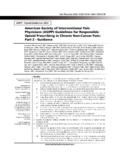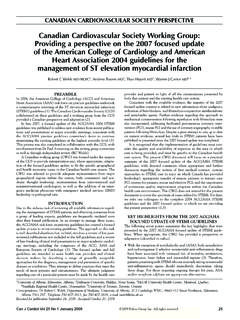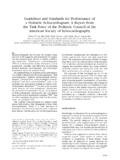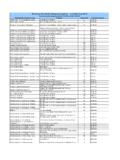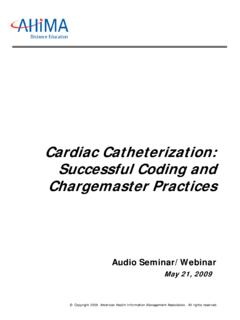Transcription of Risk factors for dental caries in young children: a ...
1 Community dental Health (2004) 21 (Supplement), 71 85 BASCD 2004 Risk factors for dental caries in young children: a systematicreview of the literatureRebecca Harris1, Alison D Nicoll1, Pauline M Adair2 and Cynthia M Pine11 WHO Collaborating Centre on Oral Health in Deprived Communities, University of Liverpool dental School, England; 2 Departmentof Clinical Psychology, The Royal Hospitals, Belfast, Northern IrelandCorrespondence to: Dr Harris, 5th Floor, The University of Liverpool, School of Dentistry, Pembroke Place, Liverpool L35PS, UK. E-mail: To conduct a systematic review of the literature on risk factors for dental caries in deciduous teeth of children agedsix years and under, to give a scientific framework for the international collaborative studies on inequalities in childhood Accepted guidelines were followed.
2 Studies were identified by electronic searching and reviewed on the basis of key words,title and abstract by two reviewers to assess whether inclusion criteria were met. Copies of all articles were obtained and assessedfor quality according to the study design. Results 1029 papers were identified from the electronic search, 260 met the prima facieinclusion criteria. 183 were excluded once full copies of these papers were obtained. Of the 77 studies included, 43 were crosssectional, 19 cohort studies, 8 case control studies and 7 interventional studies. Few obtained the highest quality scores. 106 riskfactors were significantly related to the prevalence or incidence of caries . Conclusion There is a shortage of high quality studiesusing the optimum study design, a longitudinal study.
3 The evidence suggests that children are most likely to develop cariesif Streptococcus Mutans is acquired at an early age, although this may be partly compensated by other factors such as good oralhygiene and a non- cariogenic diet. Diet and oral hygiene may interact so that if there is a balance of good habits by way ofmaintaining good plaque control and bad habits by way of having a cariogenic diet, the development of caries may be words: risk factors ; dental caries ; early childhood cariesIntroductionDental caries is widely recognised as an infectiousdisease induced by diet. The main players in the aetiol-ogy of the disease are; a) cariogenic bacteria,b) fermentable carbohydrates, c) a susceptible tooth andhost and d) time. However, in young children bacterialflora and host defence systems are in the process ofbeing developed, tooth surfaces are newly erupted andmay show hypoplastic defects, and their parents mustnegotiate the dietary transition through breast/bottle feed-ing, first solids and childhood tastes.
4 Thus it is thoughtthat there may be unique risk factors for caries in infantsand young children (Seow, 1998).It is disconcerting to see rampant caries in youngchildren (Fass, 1962). The pattern of decay is typicallythat many teeth are affected, with caries developingrapidly, often soon after the teeth have erupted. Surfacesusually at low risk of developing caries are affected suchas the buccal surfaces of maxillary incisors with theobvious consequence of affecting the child s facialappearance. It is this pattern of caries that has beenlabelled variously as baby bottle tooth decay , nursingcaries and night bottle mouth . However, since theseterms suggest that the prime cause of such caries isinappropriate bottle feeding and current evidence sug-gests that although use of a sugar-containing liquid in abottle at night-time may be an important aetiologicalfactor, it may not be the only or the most importantfactor, it is now recommended that the term early child-hood caries be used when describing any form of cariesin infants and pre-school children (Reisine and Douglass,1998).
5 The answer to the question What causes early child-hood caries ? is an important, if a complex one. Itconcerns those in both developed (Holt et al., 1996;Wendt et al., 1996) and developing countries (Matee etal., 1994; Ye et al., 1999) where many children experiencethis pattern of disease. Understanding the aetiology ofthe disease has a direct influence on public policy. In theUnited Kingdom, the British Society of PaediatricDentistry recommend a reduction in sugar intake by thewhole child population in the country. The policy recom-mended by the equivalent professional society in America,on the other hand is that sugar restrictions can be relaxedin a society where fluoride is used frequently, particularlyfor children who have low or no caries (although this isnot a universally held view amongst dentists in America),(British Society of Paediatric Dentistry, 1992; AmericanAcademy of Pediatric Dentistry, 1989).
6 How aetiology isinterpreted also influences the design of interventionalprogrammes set up to prevent the that may be implicated in giving rise to cariesin young children have been described in a number ofreview papers (Federation Dentaire Internationale, 1988;Horowitz, 1998; Moss, 1996; Reisine and Douglass, 1998;Seow, 1998). However none of these have employed asystematic methodology. The body of evidence in thisarea is large, and without a systematic approach wherestrategies for identifying and selecting information are72defined and data quality taken into account, reviews maybe open to bias and be the primary objective of this systematicreview is to identify risk factors for dental caries in thedeciduous teeth of children aged six years and under, inorder to help development of systematic approaches forpreventive oral care programmes world-wide and in orderto provide sound information for oral health promotionand public health care.
7 A secondary objective is todescribe the extent to which relationships between riskfactors are explained by ethnic group and of the reviewThe review was undertaken as part of an internationalcollaborative oral health research programme aiming todetermine interventions which might reduce dental cariesin children in disadvantaged communities and minimisethe effects of exclusion from health care systems anddisadvantage related to ethnic diversity. Whilst theprimary objective of the review was to identify all riskfactors for dental caries in the deciduous dentition, infor-mation on ethnicity and socio-economic descriptors wasgathered for all studies included so that interactionsbetween these and other risk factors could be taken intoaccount. The review was conducted in general accord-ance with guidelines promulgated by The CochraneCollaboration (1997).
8 Data sourcesIn view of the large body of literature the review is limitedto studies identified by computer searching. Handsearchingof journals and gathering of unpublished reports andconference proceedings was outside the scope of thereview at this stage. The PubMed database was searchedusing the search strategy: dental caries AND child AND(risk OR disadvantage OR ethnic) AND (toothbrushingOR sugar {Text Word} OR diet, cariogenic OR dietarysucrose). The search included all literature published from1966 onwards and was last updated in April 2002. Thetitles, authors and abstracts from all studies identified bythe electronic search were printed and reviewed inde-pendently on the basis of keywords, title and abstract bytwo reviewers (CP, PA) to determine whether these metthe inclusion criteria. In cases where there was uncer-tainty regarding the relevance of an article, a full copyof the article was obtained.
9 A full copy of all relevantarticles selected for the review was obtained prior tocommencement of the analysis of the selectionThe outcome considered in the review is the presenceand severity of caries in deciduous teeth. If the outcomewas another measure, such as Streptococcus Mutanscount, the study was not included. Where studiesinvolved age ranges of samples extending beyond sixyears of age, data were extracted where caries in decidu-ous teeth was reported for children six years and data could not be extracted the study was in all languages were extractionStudies were divided into four types of study design:cross sectional, cohort, case-control and interventionalstudies. Table 1 describes the information extracted fromeach type of extraction was performed by the principalresearcher (RH) using a previously prepared of data qualitySince there were no generic quality checklists or scalesrelevant to this review, the following quality checklistwas devised to delineate studies according to a key question was used for each study: Was thesample size adequate and appropriate for the studydesign?
10 If the answer to this question was No then nofurther quality score was applied. The decision not toinclude a study any further in the review on this basiswas confirmed after discussion with a statistician. Forthe remaining studies, these were given a quality scoreof between 0 and 4 for cross sectional and case controlstudies and between 0 and 5 for cohort and interven-tional studies. The higher the score, the higher thequality of the cross sectional studies and case control studiesthe following four questions were asked:1. Does any pre-selection of the study sample still allowthe general applicability of the study findings isselection bias acceptable? Yes/No2. Detection Bias, caries : if more than one examiner wasused, were examiners calibrated? Yes/No3.










